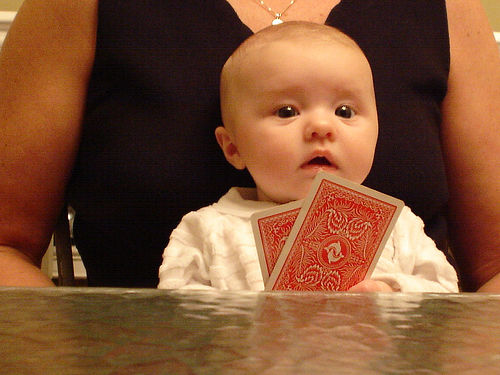Poker as Storytelling: Affect, Trickery, Common Sound

Many poker players will tell you that every hand is a story. In hold em, the four rounds of betting, the exposed community cards (given to the table in a set of three, then one more, then one more), and your two hole cards, are simply a skeletonic structure around which your action (the bet, the posture, the air around the table, speech, eyes) often are the body of what occurs. Many hands of poker fail to develop into powerful hands (i.e. both players have something but often not the nuts), thus the money frequently tends toward the player that can best present himself in a light that makes him seem provocative, working, putting fear in the other player. It becomes a question of who can tell the most believable story: if I believe that you have me crushed, and I acquiesce, it does not matter what you actually have.
The best poker players in the world, then, aren’t those who catch the most cards (as over time fate levels all), but those who are the most effective in masking their weakness, and exposing the weakness of the other. One of the biggest mistakes a neophyte makes when bluffing is failing to make their bluff make sense: they simply push hard, thinking that it is sheer aggression, and not calculated stories, images, that win pots. A common basic tactic of bluffing against a hand that had been strong early in the story is to bet “scare cards,” such as cards that complete a flush or straight draw, or betting an ace on the river when the high card had been a queen before. Betting as if the scare card completed your drawing hand, whether it does or not, can be enough to make weaker player fold. When scare cards don’t come, late bluffing is more easily picked off, as it is harder to give a player credit for a hand.
At higher levels, though, players are more aware of the tactics of storytelling. They are also aware that you are aware of them being aware, so the levels of who is representing what when and what do they think you think are constantly in flux, making high level poker play sometimes as exciting on a visceral level as writing that takes risks (both making it, and consuming it). There is a mash up of gut instinct, rational odds, emotional texture, board texture, physical surroundings (what do the opponent’s shoulders tell you about his or her hand? what do his or her eyes? how the chips are moved? the breathing. etc., not to mention the retro-image of what each player did three hours ago, three months ago, three years, up to right now), together create a continuity of immediate and retroactive value which in sum creates an environment to be processed, reacted to, explored, and yet is as cut and dry on the base level as a sentence printed on a page. Great players can seem as if they know exactly what you are holding in the midst of a hand. The greatest players go even beyond that, as if they not only see your hand, but now will draw you down another leg of the story, cause affect to you, do you some kind of rupture. Certain kinds of play, beyond money, can affect your spirit, your persona. A great session of poker, like an exceptionally great text, can make or break your month or year.
